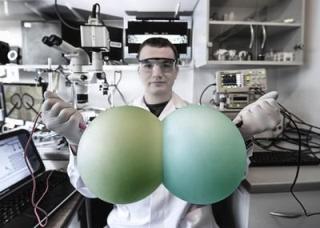Jan 8 2015
Life processes depend fundamentally on phenomena occurring on the membranes separating cells from their environment.
 A bilayer lipid membrane is formed at the junction of two droplets. The phenomena occurring on it can be analyzed by the appropriate electrodes. The idea of constructing a microfluidic system for serial studies of cell membranes is presented by PhD student Tomasz Kamilski from the Institute of Physical Chemistry of the Polish Academy of Sciences in Warsaw, Poland. Credit: Polish Academy of Science, Grzegorz Krzylewski
A bilayer lipid membrane is formed at the junction of two droplets. The phenomena occurring on it can be analyzed by the appropriate electrodes. The idea of constructing a microfluidic system for serial studies of cell membranes is presented by PhD student Tomasz Kamilski from the Institute of Physical Chemistry of the Polish Academy of Sciences in Warsaw, Poland. Credit: Polish Academy of Science, Grzegorz Krzylewski
Hitherto poorly understood, the mechanisms responsible for transport through the cell membrane will be able to be studied faster and more cheaply - thanks to the microfluidic system developed at the Institute of Physical Chemistry of the Polish Academy of Sciences in Warsaw. The system enables the serial formation of cell membranes and measurement of the processes taking place on them.
Cell membranes separate the interior of the cell, bustling with life, from its surroundings. Despite such a fundamental role, many details of the mechanisms responsible for the functioning of cell membranes remain unknown. The main factor inhibiting the progress of research is the difficulty in creating a nanometer-thick membrane for experimentation. Soon the study of cell membranes is to become easier - thanks to the microfluidic system developed at the Institute of Physical Chemistry of the Polish Academy of Sciences (IPC PAS) in Warsaw, Poland, in co-operation with the Chemical Research Laboratory at Oxford University.
Typical cell membranes consist of two layers of phospholipids, with which various types of proteins bind in different ways. For several years, bilayer membranes have been prepared in the laboratory by bringing into contact two droplets, each coated with a monolayer of lipids. If the process is performed skillfully, the drops do not merge and a lipid bilayer is formed spontaneously at the interface. This method is known as Droplet Interface Bilayers (DIB).
"Working with the group of Professor Hagan Bayley of Oxford University, we have constructed a microfluidic system which not only automates the process leading to the formation of highly stable contact at the interface of two microdroplets to form a bilayer, but also enables us to carry out electrophysiological measurements. We are able to follow the process of, for example, the incorporation of a specific protein in the cell membrane, in the presence of various inhibitors", says Prof. Piotr Garstecki (IPC PAS).
In the new microfluidic system, there are two types of droplets coated with lipid monolayers formed inside microchannels filled with oil: one type of droplets contains a solution of a protein capable of incorporation into the cell membrane, the other contains a neutral liquid or inhibitors capable of binding with the protein in the other type of droplet. When two microdroplets, each of a different type, flow into a miniature measuring chamber, they are precisely positioned by hydrodynamic traps developed by IPC PAS together with the technology company Scope Fluidics.
"The task is not a simple one. The membranes we are examining have a thickness of a few billionths of a metre, and they are easy to break. With the hydrodynamic traps we can not only stabilize the position of the droplets, but also prevent vibration of the membranes that occurs naturally during flow", explains PhD student Magdalena Czekalska (IPC PAS).
The real advantage, however, is the ability to perform electrophysiological measurements. At the moment of formation the new cell membrane is continuous and effectively prevents the flow of charge carriers between the two droplets. But if the protein dissolved in one of the droplets resembles a tube, ust one molecule incorporated in the membrane will form a pore through which ions may flow. In the IPC PAS system these minute currents can be measured by micro-electrodes built into the measuring chamber.
"In our tests we have observed currents appearing at the moment of incorporation in the membrane of a single nanopore of alpha-haemolysin protein, provided by the Oxford group. The spike was extremely small, only about 50 picoamps (10-12 amps), but always very clear", says Tomasz Kami?ski, PhD student involved in the project, winner of the Foundation for Polish Science's VENTURES programme.
Hand-made bilayer membranes are very sensitive and usually persist from a few minutes to a few hours. Artificial cell membranes in the new microfluidic system are much more stable: their lifespan is up to several days. At the same time, the system allows for the detachment of one of the droplets leading to the destruction of the existing membrane, and the attachment of a new droplet, which involves the creation of a new membrane. The membrane protein dissolved in one droplet can therefore be tested with many droplets containing various concentrations of inhibitors blocking the nanopores. Importantly, the whole measurement cycle - the separation of the droplets, rinsing of the microelectrodes, the contact of new droplets, the formation of a membrane and the measurement finished off with the observation of the incorporation of the protein in the cell membrane - can take as little as three minutes.
"The measurements we have carried out are proof that functional cell membranes are created in the new microfluidic system. We thus have fully automated measurements with minimum consumption of the reagents and samples necessary to carry out our experiments. The road to high-throughput studies of the mechanisms involved in cell membranes has been opened", concludes Prof. Garstecki.